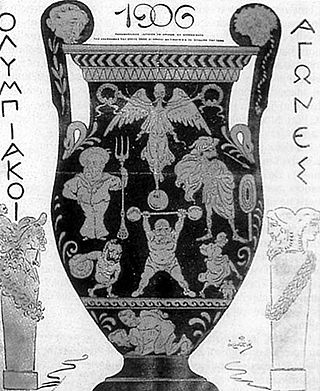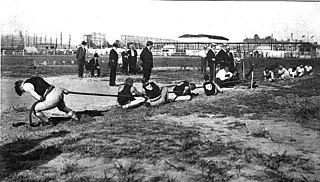
The 1906 Intercalated Games or 1906 Olympic Games, held from 22 April 1906 to 2 May 1906, was an international multi-sport event that was celebrated in Athens, Greece. They were at the time considered to be Olympic Games and were referred to as the "Second International Olympic Games in Athens" by the International Olympic Committee (IOC). However, the medals that were distributed to the participants during these games were later not officially recognised by the IOC and are not displayed with the collection of Olympic medals at the Olympic Museum in Lausanne, Switzerland.

The 1904 Summer Olympics were an international multi-sport event held in St. Louis, Missouri, United States, from 1 July to 23 November 1904. Many events were conducted at what is now known as Francis Field on the campus of Washington University in St. Louis. This was the first time that the Olympic Games were held outside Europe.

A bronze medal in sports and other similar areas involving competition is a medal made of bronze awarded to the third-place finisher of contests or competitions such as the Olympic Games, Commonwealth Games, etc. The outright winner receives a gold medal and the second place a silver medal. More generally, bronze is traditionally the most common metal used for all types of high-quality medals, including artistic ones. The practice of awarding bronze third place medals in the Olympic Games began at the 1904 Olympic Games in St. Louis, Missouri, before which only first and second places were awarded.

Judo at the 2004 Summer Olympics took place in the Ano Liossia Olympic Hall and featured 368 judoka competing for 14 gold medals with seven different weight categories in both the men's and women's competitions. Japan dominated the event by taking 8 gold and 2 silver medals.

The 1904 Summer Olympics were held in St. Louis, Missouri, United States from July 1 to November 23, 1904, as part of the St. Louis World's Fair.

The United States hosted the 1904 Summer Olympics in St. Louis, Missouri. American athletes won a total of 231 medals, setting a record for the most medals won at a single Olympics that still stands today.
The men's team épée was one of four fencing events on the Fencing at the 1908 Summer Olympics programme. The event was won by the French team, who also swept the medals in the individual épée event. Each nation could enter a team of up to 8 fencers, with 4 fencers chosen for each match.

George Louis Eyser was a German-American gymnast who competed in the 1904 Summer Olympics, earning six medals in one day, including three gold and two silver medals. Eyser competed with a wooden prosthesis for a left leg, having lost his leg after being run over by a train. Despite his disability, he won gold in the vault, an event which then included a jump over a long horse without aid of a springboard.

The men's sprint was a track cycling event held as part of the Cycling at the 1964 Summer Olympics programme. It was held on 17 and 18 October 1964 at the Hachioji Velodrome. 39 cyclists from 22 nations competed. Nations were limited to two cyclists each. The event was won by Giovanni Pettenella of Italy, the nation's second consecutive and fourth overall victory in the men's sprint. Sergio Bianchetto took silver, making it the second consecutive Games in which Italy had two men on the podium in the event. It was also the fifth straight Games with Italy taking at least silver. Daniel Morelon of France took bronze, the first of his record four medals in the event.
William Bernard Seiling was an American tug of war athlete who competed in the 1904 Summer Olympics. He was born in St. Louis, Missouri and died in Rural-Meramec. In the 1904 Olympics he won a silver medal as a member of Southwest Turnverein of Saint Louis No. 1 team.

Orrin Thomas Upshaw was an American tug of war athlete who competed in the 1904 Summer Olympics. In the 1904 Olympics, he won a silver medal as a member of Southwest Turnverein of Saint Louis No. 1 team. He was born in WaKeeney, Kansas and died in St. Louis, Missouri.
August Henry Rodenberg was an American tug of war athlete who competed in the 1904 Summer Olympics. He was born and died in St. Louis, Missouri. In the 1904 Olympics he won a silver medal as a member of Southwest Turnverein of Saint Louis No. 1 team.
Charles Haberkorn, later Habercorn, was a German-American tug of war competitor and wrestler who participated in both sports in the 1904 Summer Olympics.
Oscar Charles Friede was an American tug of war athlete who competed in the 1904 Summer Olympics. He died in St. Louis, Missouri. In the 1904 Olympics he won a bronze medal as a member of Southwest Turnverein of Saint Louis No. 2 team, which is officially considered a mixed team.
Frank X. Kugler was a German-American wrestler, weightlifter and tug of war competitor who competed in the 1904 Summer Olympics and won medals in all three events.

The men's foil was one of eight fencing events on the fencing at the 1992 Summer Olympics programme. It was the twenty-first appearance of the event. The competition was held on 31 July 1992. 59 fencers from 25 nations competed. Nations had been limited to three fencers each since 1928. The event was won by Philippe Omnès of France, the nation's first victory in the men's foil since 1956 and eighth overall. Serhiy Holubytskiy of the Unified Team took silver. Elvis Gregory earned Cuba's first medal in the event in 88 years with his bronze.

The men's single sculls event was part of the rowing programme at the 1928 Summer Olympics. It was one of seven rowing events for men and was the seventh appearance of the event, which had been on the programme for every Games since rowing was added in 1900. There were 15 competitors, each from a different nation. The event was won by Bobby Pearce of Australia, the nation's first medal in the event. Silver went to Ken Myers of the United States, extending that nation's podium streak to three Games. David Collet of Great Britain took bronze; that nation had also earned a medal each time it appeared and had a five-Games podium streak.

Team races at the Summer Olympics were track running competitions contested at the multi-sport event from 1900 to 1924.

The men's sprint cycling event at the 1936 Summer Olympics took place on 6 and 7 August and was one of six events at the 1936 Olympics. There were 20 competitors from 20 nations, with each nation limited to one cyclist. The event was won, in a disputed final, by Toni Merkens of Germany, the nation's first medal in the men's sprint. Arie van Vliet took the silver medal, the fifth consecutive Games that a Dutch cyclist had finished in the top two. Louis Chaillot of France became the first man to win multiple medals in the event, adding a bronze to his 1932 silver; it was the fourth consecutive podium appearance for France.
Culver Lucias Hastedt was an American sprinter and Olympic gold medalist in 1904. He was known as "The King of the Handicaps," winning gold medals in the 60-yard dash, the 100-yard dash and the running broad jump at the 1904 Summer Olympics in St. Louis, Missouri. Also, in the Olympic Open Meet, he won the 100-yard dash and won second place in the broad jump.














